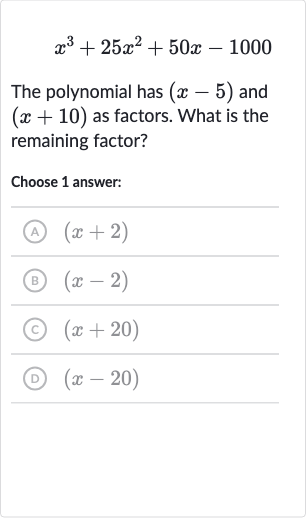AI tutor
Welcome to Bytelearn!
Let’s check out your problem:

The polynomial has and as factors. What is the remaining factor?Choose answer:(A) (B) (C) (D)
Full solution
Q. The polynomial has and as factors. What is the remaining factor?Choose answer:(A) (B) (C) (D)
- Step : Divide by : Given that and are factors of the polynomial , we can start by dividing the polynomial by one of these factors to simplify it. Let's start by dividing the polynomial by .
- Step : Polynomial Division: Perform the polynomial division of by .
- Step : Quadratic Polynomial Result: The division process should yield a quadratic polynomial as the result. This quadratic polynomial, when multiplied by , should give us the original polynomial .
- Step : Divide by : After dividing by , we find that the resulting quadratic polynomial is . This is because .
- Step : Polynomial Division: Now, we need to divide the quadratic polynomial by the other given factor, , to find the remaining factor.
- Step : Linear Polynomial Result: Perform the polynomial division of by .
- Step : Remaining Factor: The division process should yield a linear polynomial as the result. This linear polynomial, when multiplied by , should give us the quadratic polynomial .
- Step : Remaining Factor: The division process should yield a linear polynomial as the result. This linear polynomial, when multiplied by , should give us the quadratic polynomial .After dividing by , we find that the resulting linear polynomial is . This is because .
- Step : Remaining Factor: The division process should yield a linear polynomial as the result. This linear polynomial, when multiplied by , should give us the quadratic polynomial .After dividing by , we find that the resulting linear polynomial is . This is because .Therefore, the remaining factor of the polynomial , given that and are factors, is .
More problems from Factor sums and differences of cubes
QuestionGet tutor help
QuestionGet tutor help
